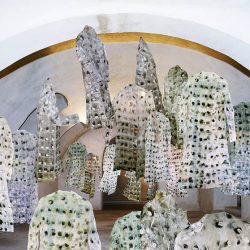A photograph H 66 x B 77 (Edition 7), offset print laminated and laminated on the rear side with 3mm Dibond
Information
Concept and photography: Tanya Ury
Digital image processing: Ingolf Pink
shower proof is an artist’s impression of the Hair Shirt Army in the vault of EL-DE-Haus, the Nazi Documentation Centre, Cologne (D), produced before the installation was actually presented from 13th February to 21st April 2014. This work is part of a series on the original Hugo Boss fashion company that employed forced labour in their production of Nazi uniforms during WW2.
***
A plastic raincoat that doesn’t let the rain in is shower proof; the function of a good shower curtain is also to keep the wet in. The image shower proof is a digital photographic collage of 19 army greatcoats, made up of little plastic bags containing date labels and Tanya Ury’s hair from natural fallout that she has collected over a period of 20 years. Implied in the title’s wordplay however, is the protection from a concentration camp shower emitting gas, not water, which these or any other coats would never have been able to provide; and the proof was in the shower. shower proof is a visual oxymoron.
***
The “pyramid” shape design of coats that appear to rise up towards the ceiling in the installation Hair Shirt Army and the image shower proof, was instilled as a visualised representation of what concentration camp functionaries were met with after a gassing took place in the gas chambers:
The concentration camps were extraordinarily efficient death factories. One witness described a typical day of extermination in the gas chambers of Auschwitz:
“Outside (…) the men on night-shift were handling a convoy of Jews, some 3,000 men, women and children, who had been led from their train into the hall 200 yards long and prominently labeled in various languages, ‘Baths and Disinfecting Room.’ Here they had been told to strip, supervised by the S.S. and men of the Sonderkommando. They were then led into a second hall, where the S.S. and Sonderkommando left them. Meanwhile, vans painted with the insignia of the Red Cross had brought up supplies of Cyclon B crystals. The 3,000 were then sealed in and gassed.
Twenty minutes later the patented mechanical ventilators were turned on to dispel the remaining fumes. Men of the Sonderkommando, wearing gas masks and rubber boots, entered the gas chamber. They found the naked bodies piled in a pyramid that revealed the last collective struggle of the dying to reach clean air near the ceiling; the weakest lay crushed at the bottom while the strongest bestrode the rest at the top. The struggling mass, stilled only by death, lay now inert like some fearful monument to the memory of their suffering. The gas had risen slowly from the floor, forcing the prisoners to climb on each other’s bodies in a ruthless endeavour to snatch the last remaining lungfulls of clean air. The corpses were fouled, and the masked men washed them down with hoses before the labour of separating and transporting the entwined bodies could begin. They were dragged to the elevators, lowered to the crematoria, their gold teeth removed with pliers and thrown into buckets filled with acid, and the women’s hair shaved from their heads. The desecrated dead were then loaded in batches of three on carts of sheet metal and fed automatically into one of the fifteen ovens with which each crematorium was equipped. A single crematorium consumed 45 bodies every 20 minutes; the capacity of destruction at Auschwitz was little short of 200 bodies an hour… The ashes were removed and spilled into the swift tide of the river Vistula, a mile or so away. The valuables – clothes, jewels, gold and hair – were sent to Germany…1
1 Leo Kuper, Genocide: its Political Use in the Twentieth Century 133 – 34 (1981), citing Milos Nyiszli, Auschwitz 1960: Ch. VII. A similar harrowing report from Hoess, the director of the Auschwitz camp, can be found at IMT Docs, supra note 231, Vol XI, transcript pgs 416 – 417 on P 149 – 49 War Crimes Against Women: Prosecution in International War Crimes Tribunals by Kelly Dawn Askin books.google.de/…
Who’s Boss — a collection of works:
- Art Prize
- Boss Rune
- Hair Shirt
- Hair Shirt Army – Armee des härenen Gewandes
- Röslein Sprach…
- Selection
- shower proof
- Soul Brothers & Sisters
- sweatshop
- Your Rules
Presentation
2014 (February/March) Flyer and poster for Who’s Boss: Hair Shirt Army in the Nazi Documentation Centre, Cologne (D)
2014 (26.2. – 26.3.) “Tanya Ury: Who’s Boss – Hair Shirt Army” by Barbara Hess, in Stadtrevue (City Revue)
